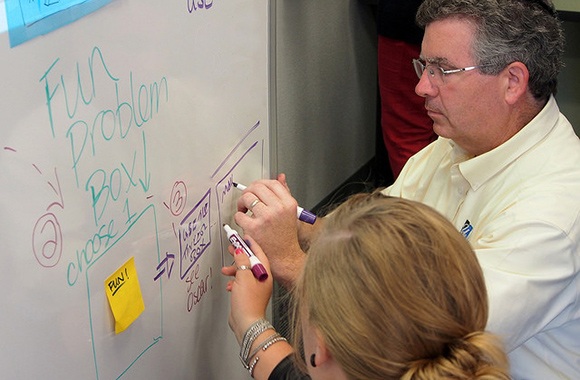
This post, which originally appeared on 7/28/15 on our blog, has been updated.
Do you ever wonder if there’s some secret sauce you can add to your campus and voila, you’ve got a fully formed innovation and entrepreneurship (I&E) ecosystem? Recently I had the pleasure of meeting with faculty and administrators from across the country who have decades of experience integrating I&E into engineering education on their campuses: Ray Vito from Georgia Tech, Nathalie Duval-Couetil from Purdue University, Liz Kisenwether from Penn State University, Andy Singer from University of Illinois at Urbana-Champaign, David Whitney from University of Florida, John Ochs from Lehigh University, Phil Kaminsky from UC Berkeley, Brent Sebold from Arizona State University, and Tom Byers from Stanford University.
As you may have guessed, according to these educators the “secret sauce” perfect solution doesn’t exist. Every school is unique; a technique that may be successful at one school may not be as effective at another. However, the group did identify nine key things everyone can do to help spread I&E on your campus:
Identify and empower faculty champions
Many successful programs begin with an inspired and charismatic faculty champion. Empower and celebrate your current champions, and identify new ones. The discipline they come from isn’t as important as the passion, energy and charisma they bring; the more disciplines and diverse backgrounds involved, the better.
Tap into student interest and energy
Increasing numbers of students are showing an interest in I&E; they’ve got ideas and energy and want to shape their academic experience. Work to engage students in all parts of your process, from customer discovery right through to promotion of events and programming. No one understands student needs better than students—and no one knows how to connect with them better than students. They are your secret weapon to designing and scaling your programming.
Centralize your efforts
Develop a centralized I&E center or space. Having a center or a space housed under the provost, for example, helps cut through potential bureaucracy and fosters interdisciplinarity among faculty and students alike.
Celebrate student successes
Students do amazing, entrepreneurial things on campus and in the world, in both core courses like Capstone design, as well as part of extracurricular offerings. Spur on others in your community by publicly celebrating these successes.
Choose your words carefully
Consider your audience and your context. The words “innovation” and “entrepreneurship” can mean different things to different people; for some members of your campus community they can feel irrelevant (or scary). Using other words to describe your goals and outcomes can be useful. At some schools, “creativity” resonates, for others it’s “design” and for still others, it’s focusing on professional skills. Get your foot in the door with language that is comfortable to your audience and then explore desired outcomes. Here’s an article I wrote on running an exercise that can help faculty arrive at a common definition of entrepreneurship.
Collaborate with the off-campus ecosystem
Entrepreneurs and investors in the community or region can serve as collaborators, advisors, mentors, guest speakers and donors. They can contextualize your programming and help sustain it. However, don’t lose sight of the passions and pursuits of students and faculty in favor of industry projects and goals; strike a balance between these two potentially competing forces. Head here for more on this topic.
Work with campus leadership
Some campus leaders believe in the benefits of integrating I&E because it can foster improved retention and GPA and better prepare students to contribute to existing organizations or start their own ventures. As a result, I&E may be integrated into the campus mission, vision, and tenure and promotion criteria. Such top-down efforts, when combined with a bottom-up approach from faculty and students, can accelerate the growth of your ecosystem. Should leaders on your campus not be of that persuasion, try introducing them to leaders at peer institutions that are; some very productive conversations may result.
Consider your context
Again, what works on one campus may not work on another. Create your own recipe for success. You could focus on integration through required courses, electives or extracurricular activities, or focus on collaborating with the off-campus ecosystem. Immerse yourself in understanding the many possibilities and various best practices. Also consider putting together a landscape inventory of your campus to understand strengths you can leverage and gaps you can fill. Epicenter’s Pathways to Innovation Program teams and student University Innovation Fellows find this approach incredibly useful.
Leverage research findings
To promote and build upon successes, use evaluation and research (generated on your campus and nationally) that demonstrates the impact of integrating I&E. Some great places to look for research include Epicenter’s Fostering Innovative Generations Studies research publications, the Journal of Engineering Entrepreneurship, ASEE conference proceedings (be sure to look at the Entrepreneurship and Engineering Innovation division), Advances in Engineering Education and VentureWell’s Open conference proceedings.
Fore more information, take a look at this case study of how the Universidad del Turabo brought I&E to their school on a shoestring budget.
About the author
 Victoria Matthew leads VentureWell’s Pathways in Innovation program. Pathways is a faculty development and institutional change initiative, focused on the integration of innovation and entrepreneurship into STEM education. The Pathways network currently includes 50 institutions and over 400 members. Learn more about how your institution can invest in being a member of Pathways in Innovation by emailing Victoria.
Victoria Matthew leads VentureWell’s Pathways in Innovation program. Pathways is a faculty development and institutional change initiative, focused on the integration of innovation and entrepreneurship into STEM education. The Pathways network currently includes 50 institutions and over 400 members. Learn more about how your institution can invest in being a member of Pathways in Innovation by emailing Victoria.